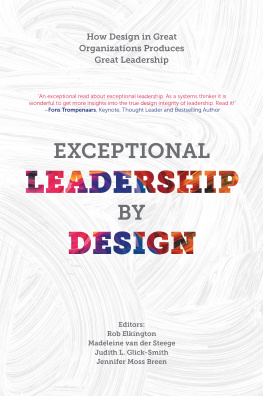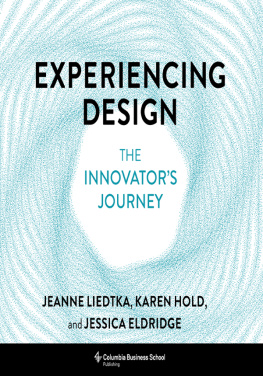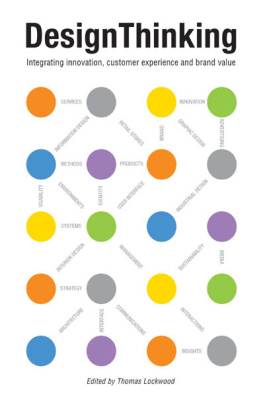DESIGN LEADERSHIP IGNITED
ELEVATING DESIGN AT SCALE
ERIC QUINT
GERDA GEMSER
GIULIA CALABRETTA
STANFORD BUSINESS BOOKS
An Imprint of Stanford University Press
Stanford, California
Stanford University Press
Stanford, California
2022 by Eric Quint, Gerda Gemser, and Giulia Calabretta. All rights reserved.
No part of this book may be reproduced or transmitted in any form or by any means, electronic or mechanical, including photocopying and recording, or in any information storage or retrieval system without the prior written permission of Stanford University Press.
Special discounts for bulk quantities of Stanford Business Books are available to corporations, professional associations, and other organizations. For details and discount information, contact the special sales department of Stanford University Press. Tel: (650) 725-0820, Fax: (650) 725-3457
Printed in the United States of America on acid-free, archival-quality paper
Library of Congress Cataloging-in-Publication Data
Names: Quint, Eric, author. | Gemser, Gerda, author. | Calabretta, Giulia, author.
Title: Design leadership ignited : elevating design at scale / Eric Quint, Gerda Gemser, and Giulia Calabretta.
Description: Stanford, California : Stanford Business Books, an Imprint of Stanford University Press, 2022. | Includes bibliographical references and index.
Identifiers: LCCN 2021016686 (print) | LCCN 2021016687 (ebook) | ISBN 9781503613966 (cloth) | ISBN 9781503629868 (ebook)
Subjects: LCSH: Leadership. | Industrial designManagement.
Classification: LCC HD57.7 .Q567 2022 (print) | LCC HD57.7 (ebook) | DDC 658.5/752dc23
LC record available at https://lccn.loc.gov/2021016686
LC ebook record available at https://lccn.loc.gov/2021016687
Cover illustration: iStock
Figure and table design: Joe Kral
Developmental editor: Jianne Whelton
Typeset by Newgen North America in 10/15 Spectral
Contents
Preface
WHY THIS BOOK WITH THESE AUTHORS
This book is the result of a shared interest in effective design leadership and how to master it within complex and ever-changing organizations. During the course of their academic careers, Gerda and Giulia have completed numerous studies on design management, done research with industry partners, published extensively on design management, and lectured at leading design and business schools. Eric, on the other hand, has a longstanding and successful professional design career that includes several executive design leadership roles in companies renowned for their design and innovation track record, including Royal Philips and 3M Company. His achievements have been cited and featured in a number of books and international publications, and Eric is a frequent guest lecturer and keynote speaker on design leadership, brand, and innovation.
In hindsight, it makes perfect sense for these three authors to collaborate on the subject matter in this book. Gerda and Giulia had originally intended to write an academic paper on effective design leadership, and to this end, they interviewed many practitioners who occupied senior design leadership roles at the time. As part of this research, they also asked Eric about the practices, methods, and approaches he considered essential for effective design leadership. The transcript of Erics replies revealed that there was so much more he could share about design leadership and that the one interview with him had only scratched the surface. During one of the conversations that followed, Eric mentioned that he had been wondering for a while when the opportunity would arise for him to capture his experiences in a book on design leadership. This made Gerda and Giulia ask themselves whether they should pivot and write a book together with Eric instead. A bookparticularly one published by a reputable publisher like Stanford University Presscould potentially reach a much wider audience than an academic article. Gerda and Giulia had gained some interesting insights during interviews they had conducted with several senior design leaders for their academic research. But these interviews were usually one-time, one-hour sessions; the idea of being able to write a book with Eric, and tap into his knowledge and experience in an unlimited way, was extremely appealing. The possibility of working with Gerda and Giulia was equally attractive to Eric, as it offered an opportunity to enrich his perspectives and reflect on his professional experience from a more academic point of view. On the basis of these considerations, the three authors decided to join forces and embark on the journey of writing a book on design leadership together.
Design Leadership Ignited is the fruit of the combined efforts of its authors. It provides practical guidance to (aspiring) design leaders grounded on the authors combined expertise and ongoing exchanges, the content and analysis of Gerdas and Giulias interviews with senior design leaders, a deep dive into relevant professional and academic publications, and Erics extensive and practical design experience as an executive design leader in complex business environments.
The main aim of the book is to provide readers with practical advice about design leadership, including several approaches to different facets of itand with this, to inspire the next generation of design leaders to become more knowledgeable and confident, and hence better at what they do. Beyond the practical nature of this work, the authors offer their reflections on and deeper insights into design leadership more generally. The basic premise is that design leadership is all about navigating contradictory imperatives, for example consolidation versus change, or conventionality versus novelty. The overarching lens used in this book is congruent with what is known as a pragmatic, antidualism perspective, which has been formulated in certain academic works on management. This integrative perspective avoids a one-sided focus on one particular aspect over another. With this book, design professionals are encouraged to embrace complexity and resolve seemingly opposing challenges when engaged in leadership. Embracing the complexity of design leadership, rather than getting distracted and made ineffective by it, will elevate design at scale.
Acknowledgments
We would like to thank our colleagues and peers who contributed to the writing of this book on design leadership. The book would not have been possible without their inspiration, advice, and support. In particular, our gratitude goes out to the many design leaders interviewed for sharing their rich experiences; to the editorial and production team at Stanford University Press for recognizing the value of this book and for assisting in the publishing process; and to the reviewers of the manuscript for their constructive feedback that resulted in a better book.
Finally, we would like to offer a heartfelt thanks to our families and friends for offering their never-ending support in so many waysbut most especially, for engaging in endless conversations on a topic that we are so passionate about: design leadership. Without this support, we could never have overcome the unique challenge of working from home across three different continents and three different time zones. In the end, the realization of this book was a truly global collaborationan act of creativity and design with everyone involved.
Eric, Gerda, and Giulia
CHAPTER 1










